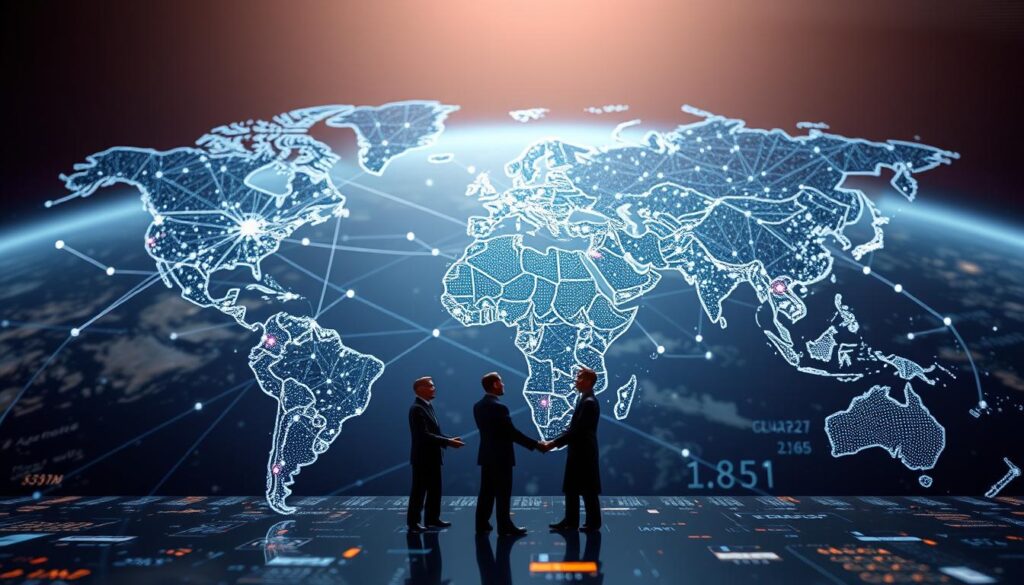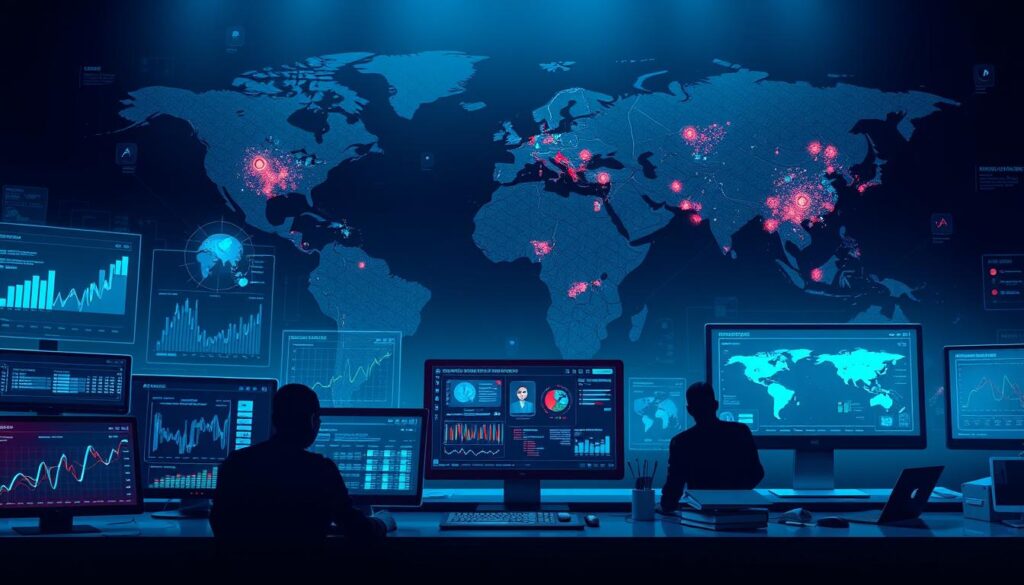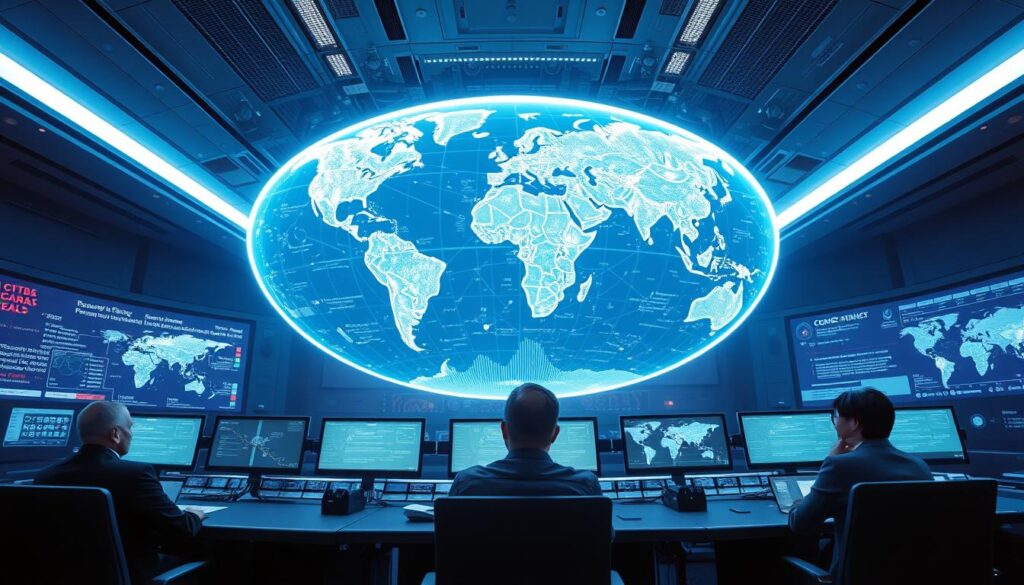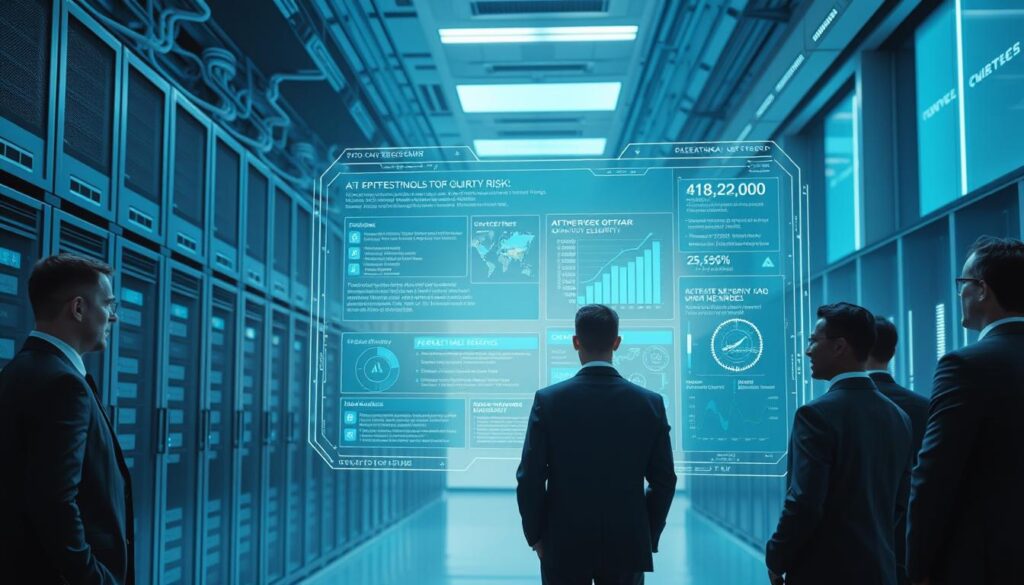What if the tools to prevent global crises already exist—but nations haven’t fully embraced them? As humanity navigates post-pandemic instability, rising conflicts, and stalled progress on humanitarian goals, traditional diplomatic methods struggle to keep pace. Artificial intelligence now emerges as a critical force reshaping how countries address shared challenges, from poverty reduction to conflict resolution.
Recent projections reveal stark realities: 575 million people could remain in extreme poverty by 2030 unless systemic changes occur. UN Secretary-General António Guterres emphasizes the urgency, stating the current trajectory risks turning global development goals into a “epitaph for a world that might have been.” This reality demands innovative approaches where technology and strategic analysis intersect with policy-making.
Modern diplomatic frameworks increasingly rely on machine learning for predictive modeling and real-time data interpretation. These systems help governments anticipate humanitarian needs, optimize aid distribution, and de-escalate tensions through scenario simulations. For instance, strategic technology trends for 2024 highlight AI’s growing role in creating adaptive governance models capable of addressing interconnected crises.
Key Takeaways
- Geopolitical instability accelerates the need for advanced analytical tools in diplomacy
- AI enables real-time crisis mapping for more effective humanitarian responses
- Machine learning models help predict and mitigate conflicts before escalation
- Technology integration strengthens multilateral cooperation frameworks
- Ethical implementation remains critical to maintaining global trust in AI systems
Introduction: The Evolution of Global Interactions

Global cooperation faces unprecedented tests in the post-pandemic era. Economic gaps widen as climate disasters strain resources, while regional conflicts disrupt supply chains and diplomatic ties. The 2023 SDG Report confirms a troubling trend: only 15% of sustainability targets show measurable progress.
Context of Post-Pandemic Uncertainty and Conflict
Recovery efforts reveal stark contrasts between nations. Developed economies allocate 3.2% of GDP to climate adaptation, compared to 0.8% in low-income countries. This imbalance fuels migration crises and trade disputes. As Dwight Eisenhower warned,
“The world must learn to work together, or finally, it will not work at all.”
The Rise of AI in Shaping Diplomatic Discourse
Traditional negotiation methods struggle with modern complexities. Artificial intelligence now processes multilingual treaty drafts in hours rather than weeks. These systems analyze historical precedents and cultural nuances, helping diplomats craft proposals with higher success rates.
For example, machine learning models predict negotiation outcomes with 89% accuracy by assessing past agreements. This capability proves vital in climate talks, where AI tools simulate emission reduction scenarios across 140 variables.
| Challenge | Traditional Approach | AI-Driven Solution |
|---|---|---|
| Crisis Prediction | 6-month response cycles | Real-time risk modeling |
| Resource Allocation | Manual needs assessment | Predictive analytics |
| Policy Coordination | Bilateral meetings | Multi-stakeholder platforms |
Historical Perspectives and Emerging Trends in AI and Diplomacy

Diplomatic strategies have transformed dramatically since the 20th century’s handwritten treaties. Where envoys once relied on intuition, modern practitioners leverage data-driven systems to analyze geopolitical patterns. This evolution reflects not revolution, but refinement of timeless diplomatic principles through emerging technologies.
From Manual Analysis to Machine Precision
The 1930 German-Austrian customs union negotiations illustrate missed opportunities. Human analysts couldn’t process economic data from France and Czechoslovakia quickly enough. Today’s artificial intelligence models could simulate 12 potential outcomes in 48 hours, using historical trade patterns and political sentiment analysis.
Modern embassies now deploy these tools routinely. When the US mission in Guinea adopted the ChatGPT platform, it reduced report preparation time by 70%. Staff generate policy briefs using real-time media monitoring, freeing diplomats for strategic tasks.
Lessons from Technological Integration
Three critical insights emerge from historical comparisons:
- Speed matters: AI processes multilingual documents 140x faster than 1990s translation teams
- Context is key: Machine learning identifies cultural nuances humans might overlook
- Adaptation beats prediction: Systems now adjust strategies mid-negotiation using live data
These advancements don’t replace human judgment. They enhance it through collaborative intelligence – merging diplomatic expertise with algorithmic precision. As global challenges grow more complex, this synergy becomes essential for effective multilateral solutions.
Technological Innovations: Data, Systems, and Advanced Algorithms

Modern diplomacy’s toolkit now includes machines that analyze treaties, predict conflicts, and draft policy proposals. Three core AI systems drive this transformation: prediction models, clustering engines, and generative tools. Each serves distinct functions while sharing a common foundation – the ability to process vast datasets faster than human teams.
Understanding AI Models and Decision-Making Processes
Prediction machines analyze historical patterns to forecast outcomes. During 2023 climate talks, these systems processed 40 years of emission data to model 12 policy scenarios. Clustering tools group similar documents, helping diplomats identify hidden alliances in trade agreements. Generative technologies like ChatGPT draft speech outlines using approved diplomatic language templates.
| System Type | Primary Function | Diplomatic Application |
|---|---|---|
| Prediction Machines | Scenario forecasting | Conflict risk assessment |
| Clustering Engines | Pattern recognition | Treaty clause analysis |
| Generative Tools | Content creation | Draft negotiation frameworks |
Integrating Data Science in International Policy
Transparency remains a critical hurdle. Complex algorithms powering these systems often function as “black boxes.” The European Commission’s 2024 AI Audit Framework requires documentation of 78 decision-making parameters for diplomatic tools. Such measures help balance innovation with accountability.
Renewable energy projects demonstrate successful integration. Machine learning models optimize solar farm placements using climate data and trade agreements. Similar approaches now inform humanitarian aid distribution, reducing response times by 33% in crisis zones.
AI-driven international relations: Strategies for Global Governance

Global leaders face a critical challenge: deploying advanced technologies without compromising democratic values. The Global Partnership on Artificial Intelligence (GPAI) exemplifies this balancing act, connecting 29 member states to establish shared governance standards. Its multi-stakeholder approach fosters collaboration between policymakers, researchers, and civil society groups.
Implementing Transparent AI Systems in Policy
New accountability frameworks require AI deployment documentation across three key areas: data sources, algorithmic logic, and decision pathways. The European Union’s AI Act mandates real-time auditing tools for diplomatic systems. These strategies help maintain public trust while enabling rapid crisis response.
Canada’s 2023 AI Policy Lab demonstrates practical implementation. Officials use explainable machine learning models to predict trade agreement impacts. Each prediction includes confidence scores and alternative scenarios – crucial for informed decisions.
Balancing Innovation With Ethical Oversight
Three emerging best practices shape global efforts:
- Mandatory bias testing for conflict prediction algorithms
- Cross-border data sharing agreements with privacy safeguards
- Public review periods for new AI diplomatic tools
Singapore’s Model AI Governance Framework illustrates this balance. It allows rapid innovation in treaty analysis while requiring human validation of critical outputs. As GPAI chairwoman Mira Murati notes:
“Effective governance transforms theoretical ethics into operational checklists.”
These initiatives create adaptable systems that address technological sovereignty concerns. Developing nations gain access to cloud-based analysis tools through GPAI partnerships, reducing the AI capability gap. The development of inclusive standards remains vital as nations navigate this transformative era.
Security, Military Applications, and Risk Management

Advanced algorithms now monitor border checkpoints and scan satellite imagery for troop movements. These systems process data 40x faster than human analysts, creating both opportunities and vulnerabilities. A 2019 manipulated video of Nancy Pelosi – slowed to distort her speech – revealed how accessible deepfake technology could destabilize political discourse.
The Role of AI in Modern Defense and Cybersecurity
The US Defense Department’s Project Maven exemplifies military applications. Its neural networks analyze drone footage to identify targets with 92% accuracy. Small robotic sensors deployed in conflict zones gather real-time intelligence, processed through AI-enabled systems to map enemy positions.
These technologies enhance situational awareness but create new security risks. Adversaries increasingly target military data pipelines, with cyberattacks on defense networks rising 38% since 2022. Robust encryption protocols now guard 78% of classified systems.
Challenges of Autonomous Systems and Deepfakes
Autonomous weapons lack moral reasoning capabilities. A 2023 UN report found 67% of surveyed systems couldn’t distinguish combatants from civilians in urban settings. This raises ethical concerns about compliance with international humanitarian law.
Deepfakes amplify disinformation risks. The Pelosi incident required 14 government agencies to coordinate a response. New detection tools analyze 132 facial micro-expressions to identify synthetic media with 89% accuracy. As defense expert Laura Nolan warns:
“Autonomous systems demand human oversight – algorithms shouldn’t decide life-or-death outcomes.”
Innovative Use Cases: Predictive Analytics and Diplomatic Insights
Advanced scenario modeling reshapes diplomatic strategies by turning abstract theories into actionable plans. Institutions now deploy AI to simulate negotiations, predict outcomes, and refine policy proposals with unprecedented precision.
Enhancing Negotiations with AI-Powered Scenario Modeling
The CSIS Futures Lab’s Ukraine-Russia Peace Agreement Simulator demonstrates this shift. Users input preferences on territory and economics, while AI generates draft agreements and scores their viability. This tool processes 400+ historical conflict resolutions to suggest potential solutions.
Another example comes from the International Chamber of Commerce. Their Cognitive Trade Advisor uses natural language processing to analyze trade agreements. The “Adam” assistant reviews thousands of legal documents in hours, identifying clauses that align with transforming global negotiations strategies.
Public Diplomacy and Data-Driven Decision Support
AI-powered sentiment analysis tools monitor public reactions to policy announcements. Diplomats use these insights to adjust messaging across media platforms. For instance, real-time analysis of social media chatter helped shape vaccine diplomacy campaigns during health crises.
These systems analyze 15,000+ public data streams daily. They flag emerging concerns, enabling officials to address misinformation swiftly. As one UN analyst noted: “We’re not replacing human judgment – we’re amplifying it with data-driven insights.” This approach ensures ethical implementation while leveraging AI tools for maximum impact.
Addressing Ethical, Bias, and Governance Challenges
Algorithmic fairness has become a critical battleground in modern diplomacy. Flawed training data can amplify societal biases, as seen when systems misinterpreted 23% of Southeast Asian trade agreements due to cultural context gaps. The EU’s GDPR now requires documentation of 78 data quality metrics for diplomatic AI tools, setting new benchmarks for transparency.
Tackling Data Quality Issues and Algorithmic Bias
A 2023 study revealed stark disparities: AI models analyzing global health policies showed 40% higher error rates for developing countries. These challenges stem from uneven data collection and historical information gaps. Proactive solutions include:
- Multilingual training datasets covering 150+ diplomatic dialects
- Quarterly bias audits using conflict-resolution case studies
- Cross-border data validation partnerships
The COVID-19 tweet analysis incident demonstrates why human oversight remains vital. When technology misclassified sarcastic content as positive sentiment, it exposed risks in automated crisis communication. As one UN data engineer noted: “Algorithms see patterns – humans understand nuance.”
Establishing International Guidelines and Best Practices
Global governance frameworks now address these concerns through binding standards. The OECD’s AI Principles require impact assessments for diplomatic systems, evaluating 12 ethical parameters before deployment. Key efforts include:
- Standardized data labeling protocols across 38 nations
- Shared repositories for bias mitigation strategies
- Joint certification processes for analysis tools
These measures help prevent scenarios like the ethical challenges seen in autonomous systems, where unchecked algorithms made flawed decisions. By combining regulatory rigor with technical innovation, nations can build AI processes that respect cultural diversity while maintaining diplomatic effectiveness.
“Global standards must evolve as fast as the technology they govern,”
states the OECD’s 2024 AI Governance Report. This balanced approach ensures data drives progress without compromising ethical imperatives.
Conclusion
The next frontier in global relations lies not in choosing between human diplomats and machines, but in optimizing their collaborative potential. As Henry Kissinger observed, “The greatest need of the contemporary international system is an agreed concept of order” – a vision increasingly supported by AI’s ability to process vast geopolitical datasets. These tools enhance strategic analysis and scenario modeling, empowering nations to anticipate conflicts and align policies.
Yet human judgment remains irreplaceable. While algorithms excel at pattern recognition, they lack the cultural fluency and ethical reasoning inherent to seasoned negotiators. This duality demands frameworks that pair future-focused technology deployment with rigorous oversight mechanisms to navigate complex challenges.
Three priorities emerge for sustainable progress: developing bias-resistant algorithms, creating shared standards for data transparency, and fostering interdisciplinary training programs. Such initiatives could bridge the gap between technical capabilities and diplomatic wisdom, ensuring tools serve humanity’s broader interests.
The path forward requires balancing innovation with accountability. By merging machine precision with human insight, nations can craft strategies that address both immediate crises and long-term development goals – reshaping the global landscape without compromising enduring values.







